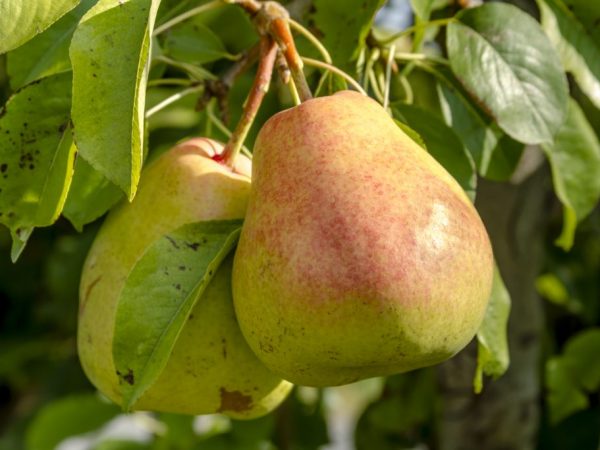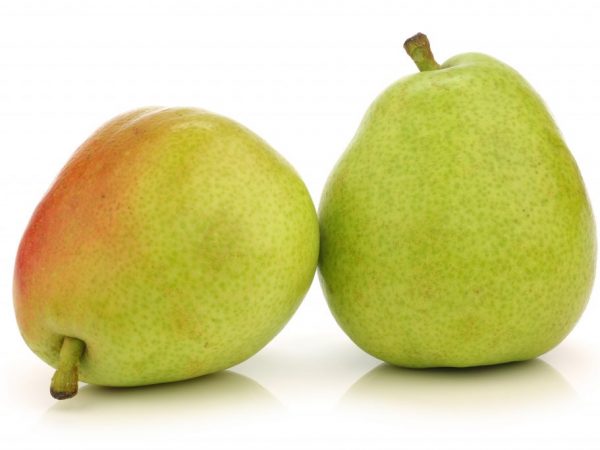Characteristics of the pear variety Osennyaya Yakovleva
Pear Autumn Yakovleva is a species with prefabricated fruiting. The variety was obtained by mixing two other varieties - Bergamot Esperen and Daughter of Blankova. We will consider a detailed description of the variety in the article.

Characteristics of the pear variety Osennyaya Yakovleva
Characteristics of the variety
This species is distinguished by good productivity and fruiting. Harvest preparation falls on the second half of August.
The pear of the Osennyaya Yakovleva variety is a self-fertile plant. But in order to achieve better yields, it is better to place an auxiliary pollinator species Lada or Avgustovskaya nearby.
- it is frost-resistant (tolerates temperatures up to -32 ° C), but requires shelter in winter;
- has a high level of drought resistance;
- bears fruit for 5 years after planting the cuttings;
- It does not require special care.
Storage in cool rooms will extend the consumption period up to 3 months. This makes the variety suitable for transportation.
Description of the tree
The tree is round and can grow up to 15 meters in height. A fairly high foliage density leads to a cluttered crown, which requires frequent pruning.
Leaves are medium in size. According to the description, they are wedge-shaped. They are directed upwards and have an oblong spine. Fruits are formed on stems and twigs.
Description of the fetus
Description of pear fruits of the Osennyaya Yakovleva variety:
- Ribbed fruits, green
- The average weight of one pear reaches 150 g. But there are also larger fruits that can reach 250 g;
- Seed chambers of the clamped type;
- The pulp is quite dense, sweet, with a nutmeg flavor.

The fruits are green, the weight of one pear reaches 150
Care
Planting pears of the Osennyaya Yakovleva variety is carried out using the traditional method. If you adhere to the correct technology, then in the end you can get a fruitful tree. To do this, you need to perform the following care procedures:
- In the spring, it is necessary to prune the tree - remove old branches and shorten the rest. This operation will limit the overgrowth of the tree and branches. Cutting off the branches will help kick-start the process for bud and fruit formation. You also need to remove stems with old flower buds. It is quite easy to identify them - they have a large number of old fruit accretions.
- At the end of April, the tree must be sprayed to get rid of fungi and pests. At the end of May, gardeners start feeding the tree with saltpeter, nitrogen, sulfuric acid. Top dressing improves the quality of the soil, which, as a result, has a positive effect on the taste of pears.
- In the hot, summer season, the plant requires abundant watering, despite the fact that pears tolerate soil drought better than other fruit crops. Do not forget that you need to water adult trees not near the trunk, but where the bulk of the absorbed roots is located (under the crown of the tree and beyond).
- In mid-September, you need to whitewash the pillars. The goal is to protect the pear from diseases, especially from ants.
It is necessary to mulch the soil. This can be done with any materials that are at hand (rotted sawdust, fine gravel, plant debris, and even paper). The soil should remain crumbly, free of weeds and not dry out.
Diseases and pests
Autumn Yakovleva has an average resistance to pests and diseases of various kinds. It is necessary to process your plant in advance for prevention purposes.
Scab
The most dangerous disease for a tree is scab. To protect the pear from scab damage when planting, only first-class seedlings and cuttings should be used. In case of illness, the affected fruits and foliage must be burned, buried or carried as far away from healthy plants as possible.
Another way to deal with scab is by spraying the tree with a freshly prepared mustard solution. To prepare the solution, dissolve 100 g of mustard powder in 250 ml of warm water. Pour the mixture into a full 10 L bucket of water.
Fungal diseases
In addition to scab, there are other diseases:
- Fruit rot. Brown rot appears on pears, which spreads very quickly and begins to occupy almost the entire area of the fruit. To solve this problem, it is necessary to spray the tree with a solution of copper sulfate immediately after harvesting.
- Sooty fungus. It is a dark, blotchy, soot-like coating. The fruits remain suitable for consumption and further processing, but their presentation, taste and shelf life are lost. To combat the disease, you need to treat the plant with infusion of tobacco dust or soap in early spring (even before bud break).
- Rust. Among the main signs of rust damage to a tree are red spots on the foliage. Treatment with Bordeaux liquid or copper oxychloride will help.
- Powdery mildew. During the defeat of this disease, the leaves acquire a powdery white bloom, which eventually becomes a reddish hue. To prevent powdery mildew, it is necessary to remove dried shoots and then burn them. You also need to periodically spray the tree.
In the autumn, to protect against pests, you need to clean the bark of the tree and whitewash it, and dig up the ground around it. This operation is recommended after rain.
Conclusion
Pear variety Osennyaya Yakovleva has a high yield and stable fertility. It contains various vitamins and nutrients.
According to gardeners, it has medium resistance to various pests and fungal diseases. It is especially strongly affected by scab. Needs constant pruning of the crown, frequent watering in hot, summer weather and treatment in order to prevent diseases.


